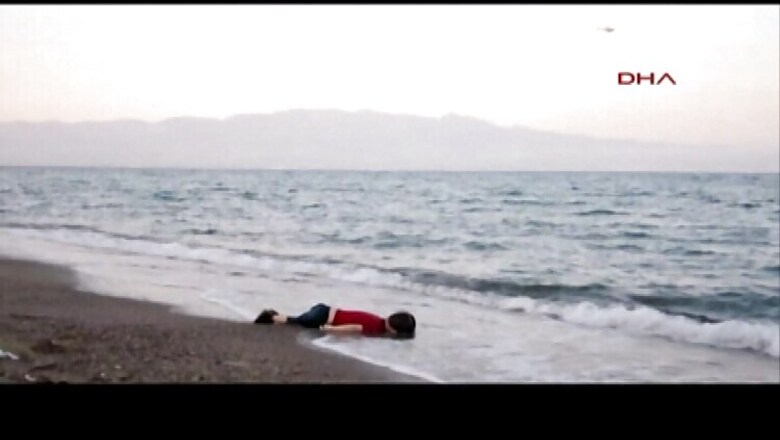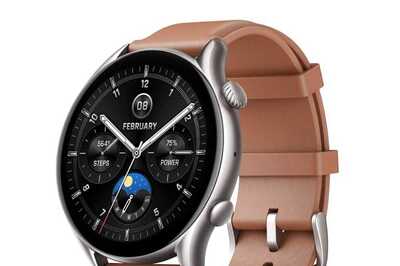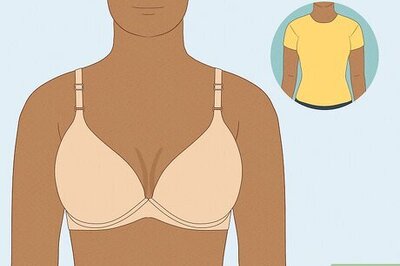
views
As they say ‘one picture is equal to one thousand words’. Sometimes a picture can be equal to a lakh words or more. Powerful pictures tell powerful stories. Some are terrible stories and some are even happy or inspiring ones.
According to British newspaper ‘The Guardian’ the full horror of the human tragedy unfolding on the shores of Europe was brought home on Wednesday as images of the lifeless body of a young boy – one of at least 12 Syrians who drowned attempting to reach the Greek island of Kos – encapsulated the extraordinary risks refugees are taking to reach the West.
The picture, taken on Wednesday morning, depicted the dark-haired toddler, wearing a bright-red T-shirt and shorts, washed up on a beach, lying face down in the surf not far from Turkey’s fashionable resort town of Bodrum. A second image portrays a grim-faced policeman carrying the tiny body away. Within hours it had gone viral becoming the top trending picture on Twitter under the hashtag #KiyiyaVuranInsanlik (humanity washed ashore).Turkish media identified the boy as three-year-old Aylan Kurdi and reported that his five-year-old brother had also met a similar death. Both had reportedly hailed from the northern Syrian town of Kobani, the site of fierce fighting between Islamic state insurgents and Kurdish forces earlier in 2015.
The publication of this picture has led to a fierce debate across the World. Many people are questioning the rationale behind publishing such a heartbreaking picture on the front pages of newspapers, showing it on TV and tweeting it and posting it on Facebook. They feel that the media should show restraint in such cases.
However, there is also a strong counter argument to it. Those who are defending it argue that such pictures will have a huge impact on rest of the World and even force the civilised nations and societies to rush for the aid of refugees fleeing the Islamic State (IS) held, war ravaged Syria and some highly unstable African nations.
Talking about the publication of video and pictures of shooting of two Virginia journalists, in an edit page piece for ‘The Guardian’ titled “Why it was right to publish this picture of an execution” Roy Greenslade writes “I asked yesterday whether the media were wrong to publish video and photographs of the killing of two journalists in Virginia. There were many intelligent criticisms of my opinion, both on my blog and on Twitter, most of which suggested I had been overly lenient to editors by suggesting that it was simply a matter of editorial (and audience) taste.
One particular critic, Liz Gerard, wrote a brilliant response on her own blog, Subscribe, which undoubtedly merits wider attention. It is long and detailed, but I’ll outline the gist of her argument.
It hinges on the difference between the publication of the images of the shooting of the journalists, Alison Parker and Adam Ward, and the publication in 1968 of a photograph taken of a Vietnamese general shooting a Viet Cong soldier at point blank range in the head.
Gerard flatly rejected my argument about the coverage being a matter of taste. Instead, she wrote: “It was a matter of judgment.”
To that end, she spent some time questioning the editorial decision-making behind both the promotion of the story and the selection of images used by most of the papers. It could only be explained, she argued, by “prurience, callousness, and lack of judgment.”
Then she contrasted the reasoning of the New York Times in publishing the Vietnam picture, observing that “the image led to wider questioning of the prosecution of the war in Vietnam and to intelligent debate about the role of war photographers.”
The pictures of Syrian refugees landing on the European soil splashed across the front pages of leading newspapers and magazines across the Globe have started a whole new debate on the crisis. These pictures might force the powerful nations to take a very strong stand on the dangers of Islamic State.
Many Europeans and European nations which were somewhat reluctant to help the refugees in a big way are now being forced to rethink. If such pictures help the bigger cause and create a worldwide awareness, publication can be justified.


















Comments
0 comment